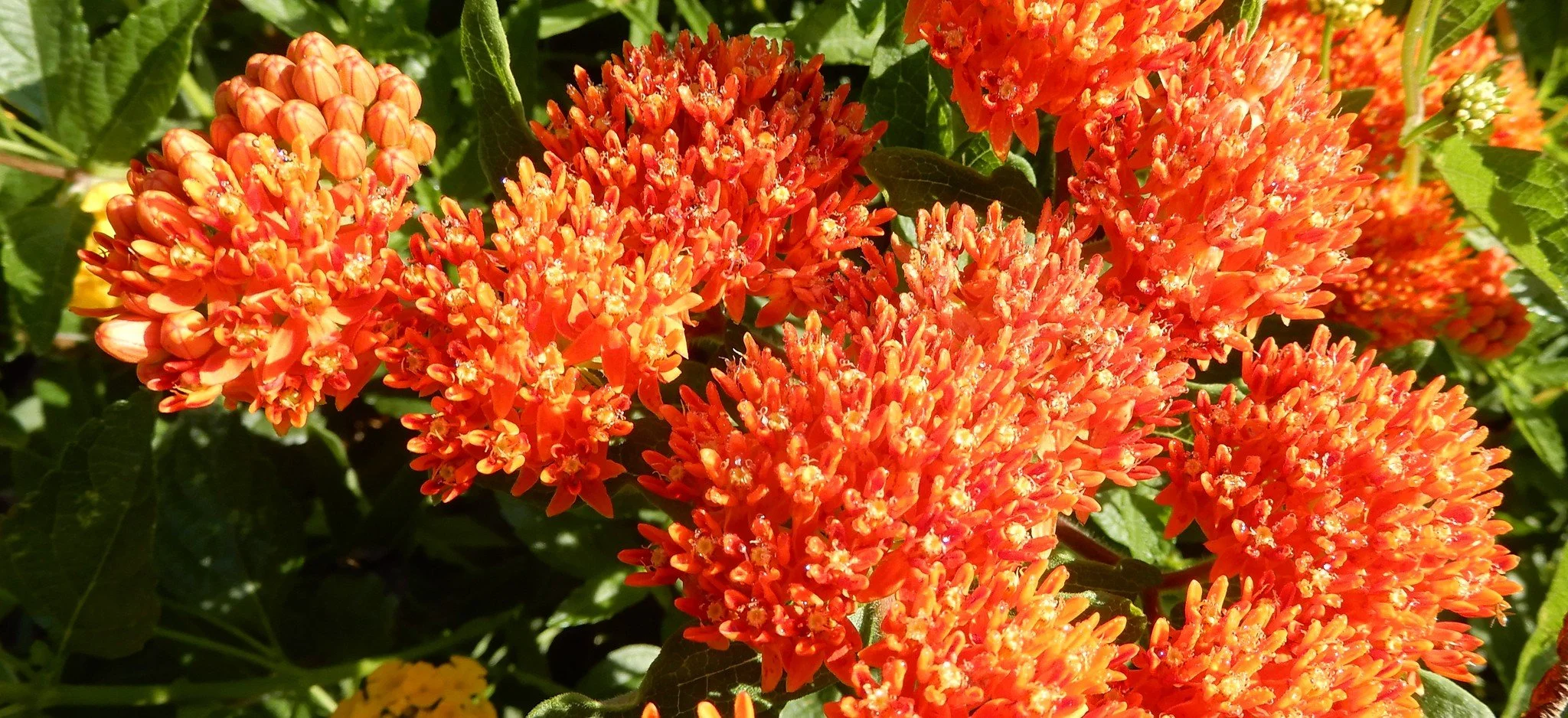8 Climate-Adapted Plants that Build Pollinator Habitat
Pick these hardy, pollinator-supporting plants for your climate-adapted garden. Photo: Martin LaBar / flickr, licensed under CC BY-NC 2.0
While we can’t be sure exactly how the climate will change, it safe to assume it will continue to get hotter and drier here. Prolonged drought makes for tough conditions for plants and the pollinating insects that depend on them. That’s where these 8 native plants come in. Each has been selected for its toughness and value to pollinators, making them durable food and shelter sources for our tremendous diversity of native bees and butterflies. Each also scores well on the low flammability index, making them suitable for a fire-defensible space. Plant a few of these and soon you’ll be ready to certify your native garden as part of the Coal Creek Pollinator District.
How to use low flammability ratings
In the right conditions, all vegetation will eventually burn. But these plants contain enough internal moisture to resist ignition. The higher the score on Colorado State University’s flammability index, the safer the plant to be close to your home.
8 Climate-Adapted Plants that Build Pollinator Habitat
1. Nodding onion (Allium cernuum)
Low flammability rating*: 10
With scores of purple, june-blooming flowers arranged in the asterisk configuration common to ornamental Alliums, the nodding onion can serve as a focal point in your garden. It is adaptable with water and drought tolerant, making it a survivor in a warming climate. That rabbits eschew the strong taste is basically gravy. It grows to a foot tall and tolerates part shade. Plant it and native bees will thank you with their presence.
*Plants with higher ratings on the low flammability index are less prone to burning. 10 is the max.
Yellow stonecrop. Photo: Andrey Zharkikh / flickr, licensed under CC by 2.0
2. Yellow Stonecrop (Sedum lanceolatum)
Low flammability rating: 10
Seems like yellow stonecrop is on every list we make, and for good reason. It’s easy to find in nurseries, spreads easily but tidily, and propagating is as simple as tearing off a chunk and planting it elsewhere. But it’s the fleshy leaves that make it fire resistant. Plant it in a low-water rock garden and watch it add a bloom a beacon of yellow that calls in bees and butterflies in the height of summer (July to August).
Common yarrow Photo: Peter Stenzel / flickr, licensed under CC BY-ND 2.0
3. Common yarrow (Achillea millefolium)
Low flammability rating: 9.5
My favorite thing about the common yarrow is its Latin name. You may notice in there the name of Ancient Greek hero Achilles who was known equally for his skill on the battlefield as for his skill with healing and medicinal herbs. Chew the leaves, apply to wound. The common yarrow is also a fighter, growing 1-2 feet tall and blooming white (always white: cultivars can produce yellow or red blooms but white is the native) and thriving on neglect. That’s a lot of pollinator value for essentially zero gardening effort.
Western spring beauty. Photo: Philip Bouchard / flickr, licensed under CC BY-NC-ND 2.0
4. Western spring beauty (Claytonia lanceolata)
Low flammability rating: 9.5
Shade can be a difficult niche to fill in the native landscape — there’s just so much sun here. But let this low-growing (.5-1 foot), white-blooming flower be first food for native pollinators. Flowering from March to April, the spring beauty is ready for showtime sometimes before the final snow of the season. Bumblebees and carpenter bees will be as glad to see it as you are. Plant it in an area of deep shade, where the ground retains some moisture, for best results.
Sand lily. Photo: Cecelia Alexander / flickr, licensed under CC0 1.0 Universal
5. Sand lily (Leucocrinum montanum)
Low flammability rating: 10
Don’t let the delicate flowers fool you. This plant is tough as nails, often seen growing in the bare dirt between prairie dog mounds when nothing else but yucca can seem to get something going. The sand lily blooms in May and hangs close to the ground (less than .5 feet tall). It scoffs at supplemental water but likes a bit of sand. Butterflies think its the bees knees.
Prairie bluebells. Photo: Keith Ewing / flickr, used under CC BY-NC 2.0
6. Prairie Bluebell (Mertensia lanceolata)
Low flammability rating: 10
Late spring wouldn’t seem complete without the bluebell. This purple-blue flower is just where it’s at for bumblebees, offering an important source of nectar for 16 different ones (including the common Bombus huntii). It’s happy in shade, especially where the ground doesn’t stay super dry for long periods, and pushes up 1-2-foot stems. Combined with a beginner-friendly care regime, this plant gives way more than it gets.
Utah serviceberry. Photo: Jim Morefield / flickr, used under CC BY-SA 2.0
7. Utah Serviceberry (Amelanchier alnifolia v. utahensis)
Low flammability rating: 7.5
I mean, just look at that thing. It’s blooming profusely in the arid hills of its native range. Serviceberry flowers are adored by native bees and solitary leafcutter bees use its leaves to cap their nests. Come summer, edible fruit ripens and you’ll be lucky to get to it before the birds clean it all out. While still scoring well on the low flammability index, it’s best sited at least 20 feet from your house for fire-wise applications. It’s also drought tolerant once established and can thrive on very little water.
Common butterfly weed. Photo: Martin LaBar / flickr, licensed under CC BY-NC 2.0
8. Common butterfly weed (Asclepias tuberosa)
Low flammability rating: 8
When the summer sun is on full blast, this orange flower is blooming its brightest. Like it’s close cousin milkweed, butterfly weed is a member of the Asclepias family. Monarchs love it but so does every other butterfly and bee around. Butterfly weed grows up to 2 feet tall and is a water sipper, making it a hardy, showy addition to your garden landscape.
Learn more about fire-wise gardening
This year, we’re offering two free workshops on using hardy, native plants to create fire-defensible pollinator gardens at your home.
April 8, 2025, 5:30-7PM, Louisville Rec Center. RSVP here
April 22, 2023, 6-730PM, Lafayette Public Library. RSVP here
The workshop is geared toward DIY gardeners who want to take on a season-size project to increase the fire-defensibility of their landscape. All participants will leave with a fire-wise planting template and everyone who attends is eligible for a random drawing for five, 50-plant kits that follow the fire-wise template.








